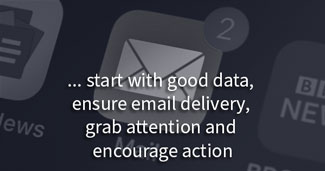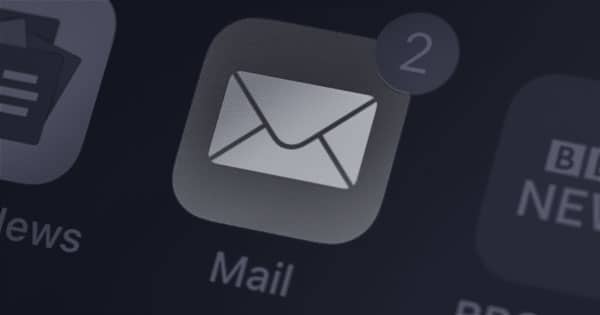If B2B lead generation is part of your job, then email marketing should be one of your tools (but not the only tool). You start with good data, ensure email delivery, grab attention and encourage action. Easy? No, it’s hard work… but worthwhile.
I’ll guide you through the four stages of a successful B2B email lead generation campaign (plus a bonus tip). I’m not just talking about cold emails that target new names/new logos – lead generation includes your existing customers (who can recommend you) and nurturing prospects long-term.
Get good data
My view is there are 3 pillars to modern marketing; data, content and relevance. But data is often overlooked. A lot of people find it boring.
Well, more fool them. Data is crucial to the success of any digital marketing programme, especially B2B email lead generation. Start by examining and cleansing your existing prospect and customer data.
Check if the emails are still live (use platforms such as Voila Norbert to check for *hard bounces). Check for accurate job titles and correct spelling of first and last names (you’ll be surprised). Any missing names and correct spelling can sometimes be taken from the email address or LinkedIn profile.

Checking for duplicate entries goes beyond examining the email address. Often people have more than one work email address, e.g. firstname@company.com as well as firstname.lastname@company.com. That means you could have the same person listed twice in your CRM.
My solution is to also capture their LinkedIn personal profile URL. This is a unique reference and helps to check for duplicates along with their email address.
Avoid duplicate companies by capturing and checking their web address as well as their LinkedIn company URL. Also, use the full company title as listed at Companies House – including the Ltd, PLC, LLC, etc. Companies House does not allow duplicate company names so it’s a useful unique identifier.
Standardise the formatting to make it easier to find duplicates. Some CRMs and spreadsheets need an exact match to identify duplicates. For example, linkedin.com/personal/graham/ and linkedin.com/personal/graham will not be seen as a duplicate (note the addition of a forward slash ‘/’ at the end).
Finally, make segmentation easier by categorising job titles. Searching for all the permutations of CEO is inefficient, much better to have a field called ‘CEO/MD/Founder’.
Also, segment the organisations by having fields for company size and industry sector. I use the data from LinkedIn as it now seems to be an industry standard.
Ensure email delivery
Another element of email marketing that gets overlooked or ignored is email delivery. Just because you click Send don’t assume it’s arrived in the Inbox.
Spambots and filters are doing a great job of quarantining emails or sending them to the Junk folder. You need to build and monitor your email reputation.
Start by checking your DMARC** and SPF*** records as well as your Spam score. If you don’t have an IT Department then WarmUpYour.email has some free tools to help you. You can also use WarmUpYour.email to help improve your email reputation.
If your organisation has never done B2B email campaigns, I recommend you start small. Limit the number of emails sent to just 20 per day. Monitor your email reputation and gradually increase.
Avoid spam words in your subject line and the body of your email. The most obvious spam words are ‘free’, ‘win’, and ‘sale’, but there are hundreds more. You can check your subject line and body text for spam words by using www.blogiestools.com
Finally, remove any email addresses from your campaign that have previously bounced. Constantly emailing inactive addresses will damage your domain. Also, ensure the email domain (@abc.com) is the same as any links in your email (www.abc.com) otherwise it looks suspicious. And always, always, always include an unsubscribe link!
Grab their attention
The subject line is the most important part of your email campaign. Spend 90% of your time on making it perfect.
Most email marketing platforms enable you to perform A:B split tests, where you can test two or three alternative subject lines. But make sure the test results are valid – check my article ‘How to test your marketing ideas and check the results are valid‘.
Segment your data into different groups. Group them by industry sector or job title. This enables you to send relevant messages to each group. A subject line that attracts someone in the construction industry may not work for people in banking. A message aimed at Finance Managers will not have the same impact on Sales Directors. Relevance is key.
Keep the subject line as short as possible; aim for 7 words, 40-60 characters. Try to include a relevant benefit for the sector or job title you are targeting.
Persuade them to take action
You’ve got great data, ensured your email gets delivered and persuaded people to open your message – now what? The simple answer is you need them to take action.
Be clear about what you want them to do. Do you want them to book a meeting, reply with information, download a document, watch a video, etc? And make it easy for them. If you want them to book a meeting give them access to your calendar so they can select a convenient time (use Calendly or something similar).
The format of your email campaign will depend on whether you are sending messages to prospects you don’t know or existing customers and prospects you are nurturing.
For prospects you don’t know I would recommend a sequence of emails (up to 4) that are delivered within a 5-day gap. If they reply to one of the emails, stop the sequence. Prospective clients rarely respond to the first email, which is why you need to send them emails 2, 3 and 4.
Keep the body text short, just a few paragraphs. Use short sentences (12-15 words) and short paragraphs (4 lines).
Avoid putting any links in the first email, it may trigger the spambots. Instead, encourage them to hit the reply button. Also, avoid using HTML if possible and keep it plain text.
For customers and prospects you are nurturing, a single newsletter is probably best. Don’t send them a sequence of emails, and don’t bombard them every week so they unsubscribe.
Your email address will probably be on their ‘safe list’ so you don’t need to worry about email delivery. This means you can use a limited amount of HTML and include images to make it look more attractive.
With this type of email, you want to teach them something they don’t already know. Educate them (see my article ‘Copy my content marketing strategy that delivers results‘). This is not the space to pitch your product or service. However, you can encourage them to share your newsletter with colleagues – this is how you can generate further leads.
Bonus tip: Obey the law
B2B email lead generation can be time-consuming if you are doing it correctly, and the UK laws that surround are complicated. But its volume and low cost mean it still delivers great ROI.
Part of the complication is that email marketing is governed by two laws; GDPR (General Data Protection Regulation) and PECR (Privacy and Electronic Communication Regulation).
Lucky for you I’ve created a blog that explains UK email marketing laws and you can access it at UK guide to B2B email marketing laws.
* Hard Bounce is an email address that has permanently failed. Usually because the address no longer exists. A soft bounce indicates a temporary failure.
** DMARC helps organisations prevent hackers from spoofing their email addresses. Spoofing is an attack where the From address is fake (e.g. it looks like hello@marketinggraham.com but is actually from criminal@hackers.com)
*** SPF also helps protect your email address against spoofing. It specifies the mail servers that are allowed to send email for your domain.
Photo by Brett Jordan
